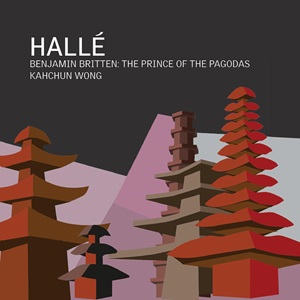
Benjamin Britten (1913-1976)
The Prince of the Pagodas, ballet in three acts (1954-1956)
Hallé/Kahchun Wong
rec. 2023, Hallé St Peters, Ancoats, Manchester, UK
Hallé CDHLD7565 [2 CDs: 129]
Benjamin Britten embarked with Peter Pears on a world tour in 1956, mid-way through the years that it took him to compose The Prince of the Pagodas. He had had a degree of difficulty, but then he visited Bali. He was so entranced by the sound of Balinese gamelan that he determined to have his ballet use its sound, mimicked by the western instruments: xylophone, vibraphone, cymbals, glockenspiel, harp, celesta, gong and pianos. The effect is considerable, particularly in Acts 2 and 3. This sound adds a degree of striking colour to the orchestration. It is first heard when we see the jewelled pagoda palace glistening in the sunlight. The gamelan music is absolutely ideal when it accompanies the scene.
Earlier, there are dances for the four kings of the North, South, East and West. Britten’s ear-catching scoring is appropriate. The King of the West gets a twelve-tone serialist treatment as Britten pokes fun at the European and American avant-garde. The King of the South’s dance majors on snarling brass and rhythmic drumming. Britten gives each of the principal characters their own distinctive melody and orchestration: an oboe melody for the heroine, a jagged string figure for her evil sister, trumpet fanfares for the prince, and alto saxophone for the aged Emperor. The whole thing is a marvel of orchestral imagination.
The ballet shows off Britten’s natural melodic gift. It is a pity that he never got round to creating a suite from it. Many more recordings could have followed.
It seems that Britten’s memories of this composing experience were not good, He did not benefit much from choreographer John Cranko’s rather hands-off attitude to the process of composition. In any case, Britten’s compositional world was very much oriented towards vocal music. He found it difficult to have to write a very long, purely orchestral piece. He also had no experience of fitting musical episodes to the physical requirements of dancers. In later years, these unhappy memories led him to be disinclined to even open the score.
Oliver Knussen and the London Sinfonietta recorded the score in 1990 for Virgin Classics. It has been many years since I heard it, but I recall being most impressed, and it is still available. The Hallé have the benefit of a three-decade advance in recording technology. That would not matter if the new version had not been produced with care, but it is good, very good in fact. The orchestra is caught with clarity and brilliance to a stunning effect. The recording venue was the Hallé’s rehearsal studio in a converted church. The sessions were spread over six days; no ‘sight-read and record’, then. I must say that earlier in-house Hallé’s discs have not struck me as benefitting from anything other than decent recorded sound, but perhaps they were made in the Bridgewater Hall or elsewhere.
I must also mention Britten’s own recording, made by Decca in February 1957. Online sources and the booklet notes of this recording state that nearly 20 minutes of music were cut in order to allow it to fit onto two LPs. I have not heard it, but for some, the fact that Britten himself is conducting the Royal Opera House Orchestra, will be recommendation enough.
This is the recording debut of Kahchun Wong, The Hallé’s new Principal Conductor. He contributes an appreciative essay on the music. The remainder of the booklet, in English, has a quite detailed description of the work’s troubled genesis. There is a brief synopsis with the 24 tracks named on each disc.
Jim Westhead
Buying this recording via a link below generates revenue for MWI and helps us keep free access to the site



















